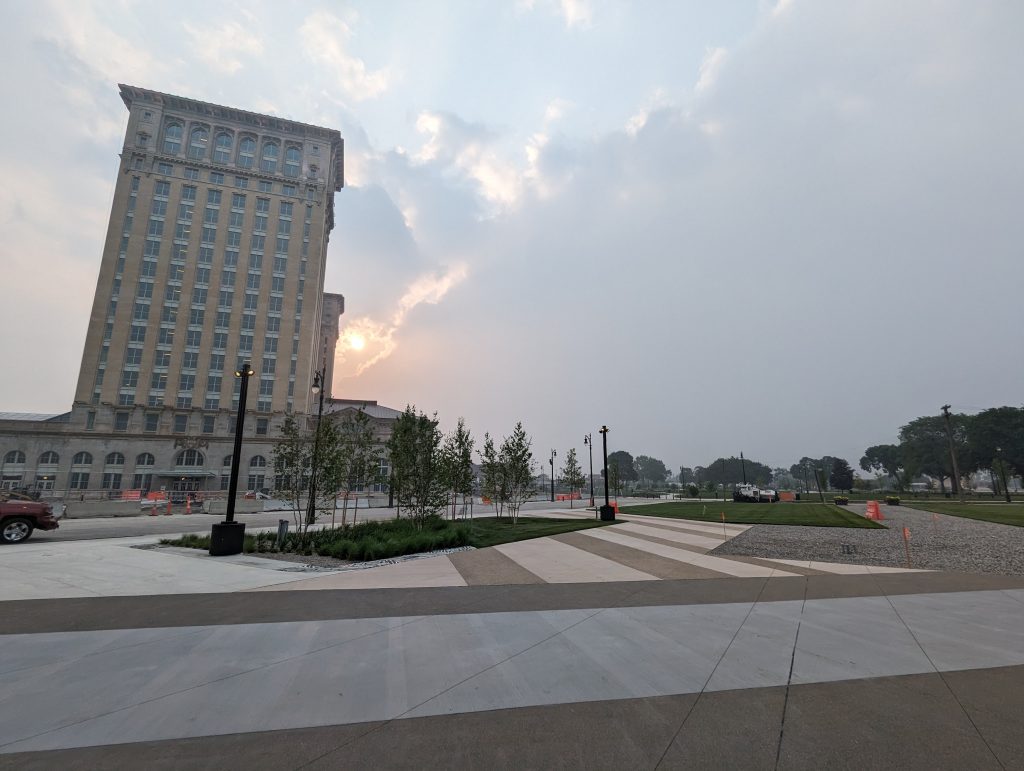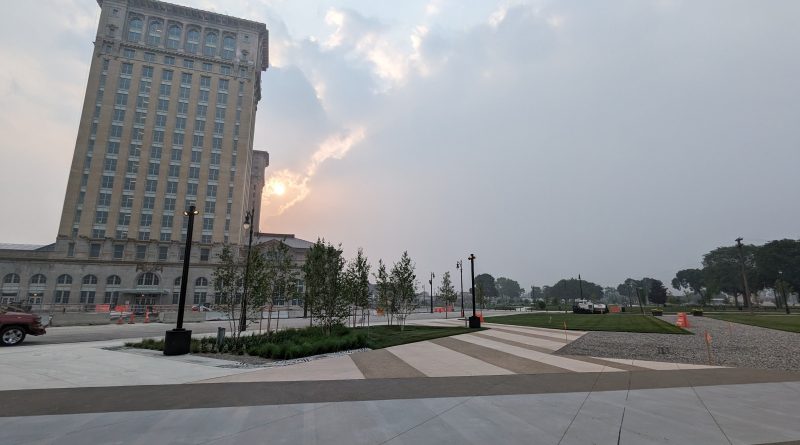Detroit Hospitals: Wildfire Smoke Likely Exacerbating Respiratory Illness.
I’ve been following the AQI levels in Detroit from lingering wildfire smoke since it arrived weeks ago– with all of the accompanying campfire smell, watery eyes, and warnings to not physically exert onesself outside. But you don’t need an AQI PM2.5-to-cigarettes-smoked calculator (!!!) to know that the sky-high AQI numbers (no pun intended) are probably pretty dangerous for people who already have sensitive respiratory tracts (myself among them) or people who already struggle with respiratory illnesses like asthma or COPD. Nor do you even need to reference the measured AQI numbers– visibility has gotten as low as several hundred feet in some places, affecting everything from air traffic control to vehicular traffic safety. To what degree, though, is the poor AQI demonstrably affecting respiratory health?
Indoor Air Quality and COVID
Pollen, Particulates, and Correlation Vs. Causality
My first question, when I started reaching out to hospitals at the top of June, was to see whether any of them had encountered increases in the incidence of ER visits, admissions, or even appointments in respiratory health issues since the beginning of the smoke. ER visits or hospital admissions are generally a good indicator of how something like air quality affects human health. This comes up a lot in the question of IAQ mitigation as healthcare providers increasingly recognize that it’s often actually cheaper to help people renovate their houses to be healthier inside than it is to provide them later with respiratory healthcare from poor indoor air quality. United Healthcare, for example, started a pilot program on this a few years ago in Detroit, and the issue has been studied extensively in places like the far reaches of Southwest Detroit, in the shadows of the Marathon Oil Refinery and Zug Island.
Of course, seeing as this platform in particular does not contain “-ew York Times,” “-etroit News,” or “-etroit Free Press” in the name, it can be very hard to get in touch with media people to get answers to these questions. (Reading between the lines, the response usually translates to, “I’m sorry, are you even a real journalist?”)
[Climate change] is likely exacerbating not only the incidence of wildfires to begin with through prolonged droughts and higher temperatures, but also the pollen count, as the growing season becomes longer with warmer temperatures.
But I did, at long last: A spokesperson for Henry Ford Health said that their providers had reported an increase in the rate of respiratory issues, but declined to provide specifics, nor to say whether they were assumed to be caused by the wildfire smoke as opposed to just high pollen counts. DMC was unable to provide a specific response by the time of publication, and Ascension Health did not respond to repeated requests for comment.
To the uninitiated, pollen counts do not factor into AQI measurements, even though they may exacerbate respiratory problems. AQI measures five very specific ingredients regulated under the Clean Air Act (which, let’s again remember, certain people in government are presently trying to eviscerate): Ground-level ozone, particulate matter (like PM2.5 and PM10), carbon monoxide, sulfur dioxide, and nitrogen dioxide. Pollen usually effects an immune response from the body (immunoglobulin E, histamine, the whole bit), while the Clean Air Act pollutants physically or chemically irritate the respiratory passages. It doesn’t matter that pollen is “natural,” but pollen is not going to cause, say, oxidative stress at a cellular level like AQI pollutants will.

The Elephant In The Room: Climate Change
I also managed to get in touch with my personal doctor, Paul Thomas from Plum Health DPC in Corktown, who confirmed that he has indeed seen an increase in cases of respiratory ailments from his patients. Thomas authored a lengthy post on LinkedIn, citing UNEP research from India that showed that poor air quality has deleterious effects on not only pulmonary health but also on brain and heart health as well as on psychological wellbeing.
But one elephant in the room, however, seems to be the fact that climate change is most likely exacerbating not only the incidence of wildfires to begin with through prolonged droughts and higher temperatures, but also the pollen count, as the growing season becomes longer with warmer temperatures. But no one seems to be terribly interested in mentioning this as a hot-button issue: hospitals, especially, are probably nervous to wade into a debate that they view as “too political”. Climate change isn’t in fact political, it’s factual. The questions about what to do about it, on the other hand, are often very political. That is, of course, a story for another day, but I’m mentioning it here because if hospitals are this reluctant to try and connect the dots between wildfire smoke and respiratory ailments, they’re going to be that much more unlikely to try and get on board with any notion of trying to mitigate the root causes.
Home Solutions
You can protect yourself from both pollen and the Five Bad Pollutants using basic things like N95 masks. You probably have some extra masks sitting around from COVID (remember that?). Wear those when you’re outside. Excluded from the CAA pollutants and not protected by an N95 mask are volatile organic compounds, which are the stinky vapors that come from gas exhaust, evaporated gasoline, etc.– these are a bigger problem in my neighborhood in Southwest Detroit, where Michigan’s business-friendly regulatory environment and an international border crossing dominated by roads clogged with diesel trucks result in increases of not only AQI numbers, but also of volatiles.
Beyond protecting yourself outside, also remember that in older housing units, or in jurisdictions that don’t enforce building code around air leakage (cough- Southeast Michigan), you also need to be thinking about this inside, too. This makes yet another great case for high-performance building design! No, you don’t need to wear a mask to sleep– but you should use a HEPA air purifier indoors if you have one. If you don’t or if you can’t afford one of these fancy machines (which some utility energy programs even offer to income-qualified customers!), there are plenty of resources online that can help you build a DIY air filter out of a box fan, high-MERV furnace filters, cardboard, and duct tape.
Stay safe, people!




